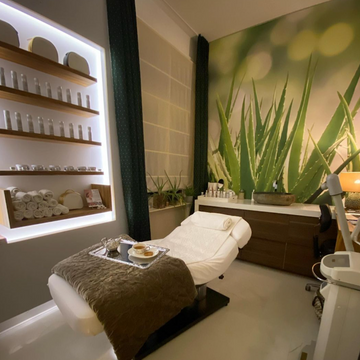- The skin is populated with billions of microorganisms collected under the term skin microbiota.
- The skin microbiota protects against invasive pathogens.
- The alteration of the skin microbiota promotes skin infections.
- The skin microbiota should be well cared for with emollients or probiotics.
The intriguing realm of microbiota holds several fascinating insights into the world of microorganisms surrounding us. Microbiota is an umbrella term for living organisms too small to be seen with the naked eye.
Microbiota and Microbiome: The terms microbiota and microbiome are sometimes used interchangeably, but they have some nuances:
Microbiota refers to the community of microorganisms in a specific environment, such as the skin or intestines, and refers to their presence and diversity.
Microbiome, on the other hand, focuses on the genetic material, such as DNA or RNA, of these microorganisms in the same environment, giving scientists insight into the genes and genetic variation within this group of microorganisms.
Here are some fascinating facts about these microscopic communities:
More Microbes Than Body Cells: It may be surprising, but our own microbes outnumber our own body cells. Our body is an ecosystem in which microbes are abundant.
Everywhere With Us: Microbes are like an aura around us; they follow us wherever we go. From our skin to our guts, these microscopic companions are everywhere.
Changes After Death: Even after death, the dynamics of the microbiota continue. Scientists have determined that the composition of the microbiota in our bodies changes after death.
Fecal Transplantation as Treatment: Fecal transplantation, in which the microbiota of a healthy donor is transferred to a patient with a disrupted gut microbiota, is a treatment option gaining increasing recognition. It can be effective in restoring a healthy gut microbiota.
Our survival depends on bacteria: Our existence is indirectly dependent on bacteria and other microorganisms. These tiny life forms are crucial for our digestion, immunity, and much more.
Here are some functions of the microbiota that support the skin:
Protection against Invading Pathogens: The microbiota helps protect the skin from invading pathogens through competition, regulation, and education of our immune system. The immune system learns to recognize which microbes are beneficial, which are harmful, and which are neutral.
Co-evolution with the Host (our body): The microorganisms in our microbiota adapt in response to changes in the host, such as age, hormonal balance, environment, and diet. This means that the microbiota and host co-evolve.
Interaction with our body: The interaction between the host (our body) and the microbiota is bidirectional. This means that the host influences the microbiota and vice versa. It is a reciprocal relationship in which both parties influence each other.
The microbiota can be described by different types of interactions:
- Mutualism (Beneficial): This is a beneficial interaction where both the microorganisms and the host (our body) benefit from the relationship. It's a win-win situation.
- Commensalism (Beneficial): In this, the microorganisms benefit from the host (our body) without causing any harm. It is beneficial for the microorganisms, but has no significant effect on the host (our body).
- Parasitism (Harmful): In this interaction, the microorganisms benefit at the expense of the host, causing damage to the host (our body).
In healthy skin microbiota, the relationship is usually mutualistic or commensal, where microorganisms and the host work together or at least do not harm each other. They protect the skin from pathogens and promote overall skin health. If this balance is disrupted, it can lead to skin disorders or other problems.
Understanding the skin microbiota and how it influences our health is a fascinating area of scientific research that is gaining increasing attention. It has also led to new approaches for developing skincare products and treatments aimed at maintaining a healthy skin microbiota.
Using natural products, such as those from Aurora Dionis Dermacosmetics, preserved with probiotics, certainly offers a valuable addition to skincare. Probiotics, such as lactobacillus, are microorganisms that naturally occur in our environment and are often associated with healthy gut microbiota. Here's how these probiotics can help restore balance to skin flora:
Skin Flora Balance: The skin's microbiota can become imbalanced due to various factors, such as harsh cleansers, overuse of antibiotics, and even environmental pollutants. This can lead to skin conditions like acne, rosacea, and other irritations. By adding probiotics, such as lactobacillus, to skincare products, these products can help rebalance the skin's microbiota. This means they contain beneficial microorganisms that can suppress the growth of harmful microbes, thus improving skin health.
Natural Preservation: Using probiotics as a preservative is also an environmentally friendly approach, as it can help avoid harmful chemicals and synthetic preservatives. This helps maintain the skin's natural balance without exposing it to potentially harmful substances.
Gentle and Natural Care: Natural skincare products with probiotics are often gentler on the skin, meaning they can be suitable for people with sensitive skin. They can help reduce irritation and redness while nourishing and protecting the skin.
Skin barrier support: Probiotics can help maintain a healthy skin barrier. A healthy skin barrier is essential for maintaining hydration, protecting against environmental aggressors, and preventing moisture loss. It also helps protect the skin from the damaging effects of free radicals.
In short, using probiotics in natural skincare products, such as those from Aurora Dionis Dermacosmetics, is an innovative approach to balancing skin flora while simultaneously supporting skin health. It contributes to a gentle and natural skincare routine that benefits both skin health and the environment.





